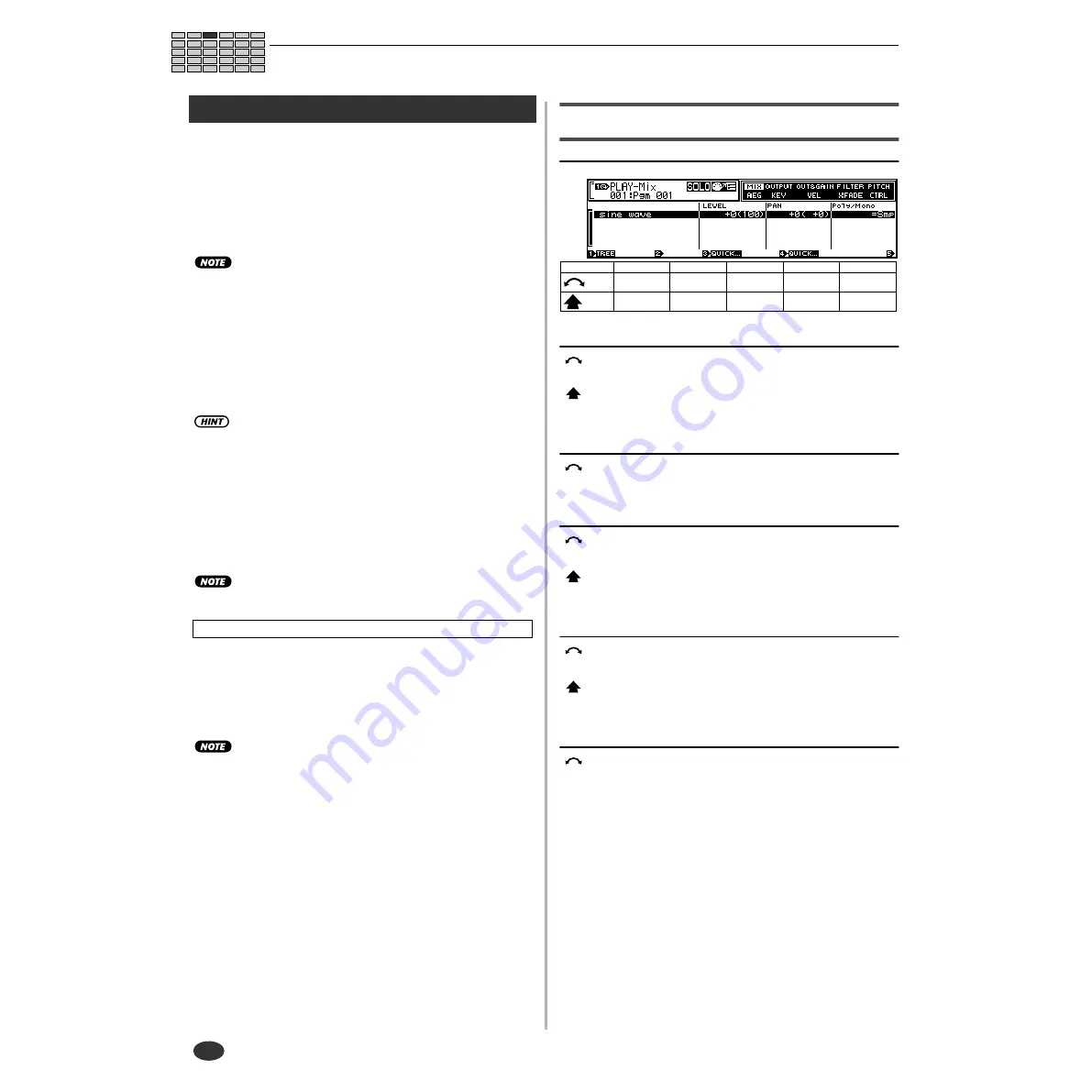
PLAY-EASY EDIT
96
Chapter 4 PLAY Mode
• A5000/A4000
● ● ● ● ● ● ● ● ● ● ● ● ● ● ● ● ● ● ● ● ● ● ● ● ● ● ● ● ● ● ● ● ● ● ● ● ● ● ● ● ● ● ● ● ● ● ● ● ● ● ● ● ● ● ●
3. EASY EDIT
Use this function to make program-level adjustments to each
sample's playback settings. You make these settings sepa-
rately for each program, and they remain effective only while
the program is selected. These changes do not affect the sam-
ple's own (local) data.
Press the [PLAY] button and then the third function button
[F3] to enter the EASY EDIT mode.
• In EASY EDIT, only the samples used by the current program are
listed.
• If EASY EDIT is entered when a sample which is not used by the
current program is selected, the EASY EDIT display will open with
none of the listed samples selected. Knob 2 can be used at this
point to select one of the listed samples.
• EASY EDIT settings will be cancelled when the "RchASSIGN"
parameter for the edited sample is set to "off" (the EASY EDIT set-
tings will not be restored when the sample is re-assigned).
• If you apply easy editing to a sample bank, the settings apply to the
entire bank. You can apply edit settings to individual samples within
the bank.
• This feature lets you adjust the way a sample operates and sounds
within a program while leaving the sample's original settings
unchanged. This is particularly useful when you wish to use the
same sample in different ways with different programs.
The EASY EDIT mode has the following 10 display pages:
Mix, Output (page 97), Out&Gain (page 97), Filter (page 98),
Pitch (page 98), AmpEG (Ampitude EG — page 99), Key
(page 99), Velocity (page 100), Xfade (Crossfade — page
100), and Control (page 101).
• See "Basic Operation" on page 78 for details on acessing the vari-
ous display pages.
The EASY EDIT mode is used to apply temporary offset or replace-
ment values for the sample's own editable parameters, and thus the
easy edit parameters are essentially the same as those provided in
the EDIT mode. In this section we'll simply list the ESY EDIT parame-
ters available and their settings. For details refer to the corresponding
EDIT mode parameters on the page numbers provided.
• Whether each parameter is an "offset" or "replacement" type is indi-
cated in parentheses after the values.
• Press "QUICK..." entry knobs for the quick-entry menu — refer to
page 83 for details.
• Press "MIDI" input knobs to set the input value from a MIDI control-
ler — refer to page 82 for details.
Mix
[PLAY] Button
→
[F3] Button
→
Knob 1 to select "PLAY-Mix"
Knob 1
[
Turn] Page
Selects display pages.
[
Press] Tree View
Calls the Tree View display (page 83).
Knob 2
[
Turn] Sample
Selects the sample to be edited.
Knob 3
[
Turn] Level (page 127)
[Range] -127 — +127 (offset)
[
Press] QUICK...
Calls the quick entry menu (page 83).
Knob 4
[
Turn] Pan (page 127)
[Range] -127 — +127 (offset)
[
Press] QUICK...
Calls the quick entry menu (page 83).
Knob 5
[
Turn] Poly/Mono (page 127)
[Range] Poly, Mono, =Smp (replace)
When "=Smp" is selected the receive channel
for each sample (page 127) is used as is.
EASY EDIT Parameters
Knob 1
Knob 2
Knob 3
Knob 4
Knob 5
Turn
action
Page
Sample
Level
Pan
Poly/Mono
Press
action
Tree View
—
QUICK...
QUICK...
—
Содержание A4000
Страница 1: ......
Страница 30: ...Sound Check 30 Chapter 1 Setting Up A5000 A4000 ...
Страница 116: ...PLAY CONTROL 116 Chapter 4 PLAY Mode A5000 A4000 ...
Страница 296: ......






























